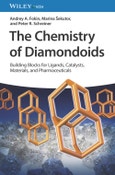The Chemistry of Diamondoids gives a state-of-the-art overview of all aspects of diamondoid chemistry, covering nomenclature, natural occurrence, chemical and physical properties, along with synthesis and functionalization of diamondoids as well as their applications as molecular building blocks in organic synthesis, polymer and materials science, nanotechnology, and medicinal chemistry. The book concludes with a perspective towards future developments in the field, thereby drawing attention to areas open for discovery.
Written by experts in the field, The Chemistry of Diamondoids includes information on: - Naturally occurring diamondoids, their formation, and the role they play in the petroleum industry and in geosciences, plus man-made approaches to prepare them on large scale- Growing diamond from diamondoids via seeding, preparation and properties of diamondoid oligomers and doped diamondoids- C-H-bond functionalization, a precondition for their use in many applications, and fine-tuning of diamondoid properties by precise cage substitution reactions
With its all-encompassing approach, The Chemistry of Diamondoids is a valuable guide for newcomers and researchers in organic chemistry and materials science interested in modern synthetic methods and organic functional materials.
Table of Contents
Preface ix
Abbreviations xi
Acknowledgments xv
Author Biographies xvii
1 Description of Diamondoids 1
1.1 Nomenclature 2
1.2 Strain 5
1.3 Preparation of Diamondoids 8
1.4 Physical Properties of Diamondoids 14
1.5 Spectroscopy of Diamondoids 18
1.6 Ionization Potentials 23
1.7 Electron Affinities 24
1.8 Vibrational Spectroscopy 25
2 Naturally Occurring Diamondoids 35
2.1 Diamondoid Occurrence in the Earth’s Crust 38
2.2 Diamondoids in Geochemical Studies 40
2.3 Diamondoid Formation in the Earth’s Crust 42
2.4 Large-scale Isolation of Natural Diamondoids 44
2.5 Alternative Natural Sources of Diamondoids 48
2.6 Other Diamondoid Derivatives in Nature 50
3 Diamondoids as Alkane CH Activation Models 63
4 Preparative Diamondoid Functionalizations 75
4.1 Halogenations 75
4.2 Diamondoid Alcohols and Ketones 83
4.3 Carboxylic Acids and Their Derivatives 98
4.4 Nitrogen-Containing Compounds 103
4.5 Phosphorous- and Sulfur-Containing Compounds 108
4.6 Single Electron Oxidations of Diamondoids 113
4.7 Other Diamondoid Derivatives 118
5 Diamondoid Self-Assembly 137
5.1 Adamantane-Containing SAMs on Surfaces 137
5.2 Higher Diamondoids for SAM Formation 146
5.3 Pristine Diamondoids on Surfaces 157
5.4 Other Applications of Diamondoid SAM Materials 157
5.5 Adamantane-stabilized Metal Nanoparticles 160
6 Growing Diamond Structures from Diamondoids Via Seeding 171
6.1 Diamondoid-Promoted Growth of Diamond Under HT-HP or CVD Conditions 171
6.2 Higher Diamondoids for Diamond Nucleation 177
6.3 Diamond Growth Inside Nanotubes 180
7 Diamondoid Polymers 193
7.1 Polymers Based on 1-Adamantyl-1-adamantane (1ADAD) 194
7.2 Polymers Based on Monofunctionalized Diamantanes 197
7.3 Polymers Based on Difunctionalized Diamantanes 199
8 Diamondoids in Catalysis 213
9 Medicinal Compounds 239
10 Supramolecular Architectures 251
11 Diamondoid Oligomers 279
11.1 Saturated Diamondoid Oligomers 279
11.2 Unsaturated Oligomers 287
12 Doped Diamondoids 305
12.1 @-Doping 306
12.2 Internal Doping 308
12.3 External Doping 318
13 Perspective 339
References 340
Index 343








